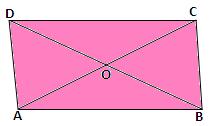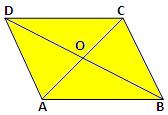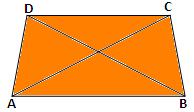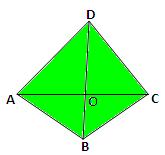Subscribe to our ▶️ YouTube channel 🔴 for the latest videos, updates, and tips.
Properties of a Rectangle Rhombus and Square
The properties of a rectangle, rhombus and square are discussed here using figure.
Diagonal Properties of a Rectangle
Prove that the diagonals of a rectangle are equal and bisect each other.

Let ABCD be a rectangle whose diagonals AC and BD intersect at the point 0.
From ∆ ABC and ∆ BAD,
AB = BA (common)
∠ABC = ∠BAD (each equal to 90o)
BC = AD (opposite sides of a rectangle).
Therefore, ∆ ABC ≅ ∆ BAD (by SAS congruence)
⇒ AC = BD.
Hence, the diagonals of a rectangle are equal.
From ∆ OAB and ∆ OCD,
∠OAB = ∠OCD (alternate angles)
∠OBA = ∠ODC (alternate angles)
AB = CD (opposite sides of a rectangle)
Therefore, ∆OAB ≅ ∆ OCD. (by ASA congruence)
⇒ OA = OC and OB = OD.
This shows that the diagonals of a rectangle bisect each other.
Hence, the diagonals of a rectangle are equal and bisect each other.
Diagonal Properties of a Rhombus
Prove that the diagonals of a rhombus bisect each other at right angles.

Let ABCD be a rhombus whose diagonals AC and BD intersect at the point O.
We know that the diagonals of a parallelogram bisect each other.
Also, we know that every rhombus is a parallelogram.
So, the diagonals of a rhombus bisect each other.
Therefore, OA = OC and OB = OD
From ∆ COB and ∆ COD,
CB = CD (sides of a rhombus)
CO = CO (common).
OB = OD (proved)
Therefore, ∆ COB ≅ ∆ COD (by SSS congruence)
⇒ ∠COB = ∠COD
But, ∠COB + ∠COD = 2 right angles (linear pair)
Therefore, ∠COB = ∠COD = 1 right angle.
Hence, the diagonals of a rhombus bisect each other at right angles.
Diagonal Properties of a Square
Prove that the diagonals of a square are equal and bisect each other at right angles.
We know that the diagonals of a rectangle are equal.
Also, we know that every square is a rectangle.
So, the diagonals of a square are equal.
Again, we know that the diagonals of a rhombus bisect each other at right angles. But, every square is a rhombus.
So, the diagonals of a square bisect each other at right angles.
Hence, the diagonals of a square are equal and bisect each other at right angles.

NOTE 1:
If the diagonals of a quadrilateral are equal then it is not necessarily a rectangle.
In the adjacent figure, ABCD is a quadrilateral in which diagonal AC = diagonal BD, but ABCD is not a rectangle.

NOTE 2:
If the diagonals of a quadrilateral intersect at right angles then it is not necessarily a rhombus.
Parallelogram
Properties of a Rectangle Rhombus and Square
Practice Test on Parallelogram
Parallelogram - Worksheet
8th Grade Math Practice
From Properties of a Rectangle Rhombus and Square to HOME PAGE
Didn't find what you were looking for? Or want to know more information about Math Only Math. Use this Google Search to find what you need.


New! Comments
Have your say about what you just read! Leave me a comment in the box below. Ask a Question or Answer a Question.